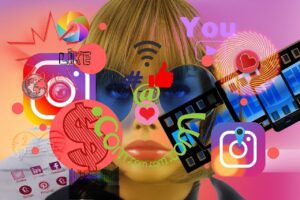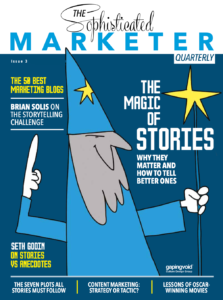
Part of an unpublished appendix for The End of Business as Usual…
The mystique of Twitter, Facebook and Google+ causes a momentary lapse of reason where businesses are surprisingly acting first and addressing “the why” at a later point in time, if at all. Without careful consideration and strategy, a great wave of stream fatigue, social blindness or far worse, customer unlikes and unfollows in will befall unsuspecting businesses en masse in social media. It will come down to a vital, but fixable disconnect. Businesses are interacting with consumers to socialize rather than learn about customer expectations to in turn, deliver tangible value, improve product experiences, and invest in long-term relationships.
While many brands are designing editorial and engagement programs to encourage consumers to “Like” and follow profiles, view videos, submit user generated content, consumers are simultaneously struggling to find signal against the noise, grappling with stream fatigue and sometimes an overwhelming sense of over connectedness.
The more discerning consumers are learning that tuning out is merely temporary relief for misdiagnosed symptoms and not a fix to their bigger problems. Once they realize that streams are programmable, that social content and relationships require thoughtful curation, and more importantly, recognize when inbound streams no longer offer usefulness, they’ll find that the only cure rests in unLikes and unFollows.
Consumers, like businesses, are learning how to navigate social streams as they go. As experience matures however, building relationships within social networks will become a quiet, but important art of curation. People will select and fine-tune the relationships they deem worthy to improve the content that flows through their streams. People, brands, products, and apps will come and go. This constant modification sets the stage for an important shift in the balance of power between brands and consumers. In social media, it’s less about caveat emptor and now about caveat venditor, let the seller beware.
This is more true than ever before, especially in light of Facebook’s chatty OpenGraph development platform. Mark Zuckerberg refers to the new movement as Frictionless Sharing. Others worry that it will spark frictionless frustration. As brands and developers experiment with sending automatic updates into the stream, friends and friends of friends will be subjected to a relentless series of action verbs in their News Feeds…
“Sarah Perez listened to Foster the People on Spotify”
“Robert Scoble read Whoops I didn’t mean for you to read this on Washtington Post Social Reader.”
The first reaction on the business side is unfortunately that of excitement. Strategists are huddling right now devising ways to send updates to trigger the social effect to expand adoption, reach, and Likes!
The first reaction on the consumer side is a mixture of concern and annoyance. People are genuinely worried that they’re going to either spam or be spammed and of course the temporary debate about privacy emerges once again.
Don’t get me wrong. It’s a bold move by Facebook and executed properly, it will increase interaction around common interests and ignite peer-to-peer commerce simply by sharing or reacting to activities. The first update to many of these Frictionless Sharing apps will be that of a mute button until developers and consumers can find the balance of what’s worthy of sharing and consuming.
Even before the OpenGraph, stream fatigue was already endemic among friends and also their favorite businesses. A friend of mine conducted an interesting social experiment earlier in the year. What Andrew Blakeley wound up uncovering were signs that brands are in fact not considering consumer experiences outside of direct brand engagement. Blakeley assumed the role of a consumer and set out to Like every brand that presented an opportunity to connect on Facebook. Ranging from email requests and web sties to TV and print advertising and real world shopping, Blakeley Liked a total of 46 brands in one week.
Out of the gate, Blakeley observed that only 10 out of the 46 brands offered a reason why consumers should Like them. Once liked, the experience only degraded. Aside from an occasional contest, he felt largely unrewarded. Most notably, he learned that the online experience for consumers was undefined or uncharted, leaving consumers to fend for themselves to find relevance within the engagement without any reinforcement to brand value or story.
Andrew summed up his experience quite humbly, “My week as a social consumer left me tired and confused. It left my Facebook newsfeed so crammed with nonsense to the point that I could scroll entire pages without seeing my friends.”
Andrew experienced stream fatigue first hand and the inability to keep up with the information that populates one’s social stream.

While brands are learning in public, it’s important to realize that earning a Like is far simpler than re-earning a Like once it’s lost. Similar to traditional online advertising, consumers can ignore marketing messages once in the stream. They can merely become immune to updates or worse, they will resort to unLiking and unfriending anyone who is taking away from the social experience.
In a study published by Exact Target in June 2011, the meanings of Fan and Like in Facebook were scrutinized. The company found that while businesses believed that consumers Like brand pages were truly fans of the company, only 42% of consumers agreed that marketers could interpret a Like as such. In fact, 33% are indecisive and 25% disagree that Likes mean that they are fans or advocates of the brand.
May I Have Your Intention Please?
With each day that passes, the social-savvy consumer will start asking brands for their intentions as requests for their allegiance escalates. Accordingly brands will have to give reasons upfront for why consumers should Like or follow them into social frontiers. Customers will want to know what’s in it for them before they open up their stream beyond family and friends. For brands, engagement comes down to understanding how to best deliver value to consumers in social networks.
The reality is that customers can and will cut ties with brands that do not take their best interests into account. Consumers are realizing that they have the power to reduce or eliminate stream fatigue by tailoring the relationships they maintain in each network. This is a new kind of power because in the past, they couldn’t manage/curate these brand relationships in the media they consumed.
Every business will eventually realize that the hype driving today’s social media is only momentary. It’s not a miracle drug that cures the ails of faceless broadcast marketing. Customers are already demanding a more useful and beneficial approach to engagement. The question is, can you deliver it in and around of your strategic campaigns?
#AdaptorDie
Order The End of Business as Usual today…
Image credit: Shutterstock






Brian, awesome post as usual (no pun intended on the book title)! I really liked this post and can relate to Andrew because I had conducted a similar excercise with brands/businesses on FB. I too got fatigued and found it much harder to see actual posts that truly mattered to me. Another interesting perspective is the impact fatigue will have on younger generations that are using FB in grade schools. I have a relative that has 800+ “friends” on FB and he has not even reached high school or college yet where he will meet so many more people. FB is obviously a tremendous tool, if used properly (but that is often underestimated), otherwise it can create a lot of noise and friction. it will be interesting to see how the “frictionless” sharing evolves and impacts social streams.
As I expressed to you at the Genesys event in Chicago last month, I greatly appreciate your efforts and love your attitude of “I give back as much as I learn.” Keep on inspiring and hustling!
very good coment..
I think the challenge for marketers is to realize and embrace that “social” means genuine two ways communications. These communications are difficult even in very personal situations and enormously more difficult to scale. As you you wrote before, most brands attempts to connect are really disguised efforts to sell. To sell more, not necessarily to sell better products. We already have means of shouting and social consumers are already tired of noise. That is why DVR technology, spam filters, and browser filters are so popular. If one really wants to connect they got to listen and relate to what is important to their customers, not how many button they click on.
I agree with you that the key word in all of this is “social.” Brands that try to attract customers without listening and relating to customers are doing themselves a true disservice. The main benefit of Twitter is that it is fast and personal. Companies should take a little more time to connect with their consumers to truly call what they are doing “social.”
Thought momentum is hard to overcome. Decades of being able to assume (or in a pinch, rationalize) that you know what your customers want, even if you didn’t have a clue and were making it all up, doesn’t just change overnight. Brands simply have to realize that they are no longer talking at people, but with them.
Regards,
Jim Ducharme
Community Manager
GetResponse
Brian, it is quite surprising that brands still fail to realize the importance of offering value in the stream. It’s a basic building block of resonance.
You really hit on it with the word “resonance.” If we were designing for resonance and not engagement, the experience would be far more valuable and lasting.
Resonance is so key and so few companies realize this in their strategies (or lack of them) and communications. The other aspect to consider in this conversation is how all social platform use changes so quickly as brands start using them for marketing. Remember how different interactions on Twitter were 3 or 4 years ago?
another thought-provoking post Brian. It’s curious to me how dynamic the situation is, and how difficult it is to stay ahead of the curve. This is particularly true for nonprofits (the field in which I work), as we’re usually later adopters. We’re all just figuring out how to get folks to ‘like’ us, and now it seems our constituents are figuring out how to ‘unlike’ us. I’ve also been hearing about a lot of people closing down their FB accounts (especially in the 20-something generation). What do you hear about that? Just as we’re figuring out the channels to be in, they move into another channel. They’re tired of the stream, indeed.
Great post on here Brian. Even more surprising to me is that 10 out of 46 brands actually interact and give people a reason for the LIKE! The trick will be beyond getting people to not unlike them is how to actually engage them. There are plenty of consumers who LIKE a business on facebook to enter a contest and get some info on one particular concept or idea but soon after that the business does nothing to engage them and while they don’t UNLIKE them they do ignore all their doings and are not an engaged customer.
Another solid observation, Brian. “The Why” question is the most overlooked element we see when analyzing social media impact for organizations. They understand “the how”, but don’t know why they are doing what they are doing. The PR and marketing industry is partly to blame as we over-hype the latest #newtools for our trades. Our guidance to clients always comes back to #SameRules, #NewTools. First understand your goals and objectives, then set out to accomplish them through the use of the new social network tools. This is fundamental and has not changed because social media exists. Rather, social media exists to further amplify the message of a well conceived strategy…in so far as PR, branding and marketing are concerned.
Brian, you nailed it with this:
“[consumers] can merely become immune to updates or worse, they will resort to unLiking and unfriending anyone who is taking away from the social experience.”
the social space isn’t for brands, brands are “allowed” to be there by consumers to the extent that they don’t ruin the experience. Once they do, they’ll either be ignored or consumers will move to a different space where the space is still social.
Truly Insightful post Brian. This is a great reminder for someone like me who manages several social media accounts for our company. Must not post too must, and must make sure that whatever I post will add value to our clients.
In my own personal use, I tend to “like” quickly – especially “new businesses on Maui”who are requesting for “likes” on their new Facebook page. However, I am also quick on unliking when i don’t see any value on the company’s posts and it just crowds my stream too much. Just thought of an idea – before I “unlike” or when I “unlike” a biz from now on, I will send them a link to this post for their info. 🙂
Now that’s an idea I really “Like!” 🙂
Wow nice!
Found your discussion to be one of the most succinct and insightful that i have read in a long time. One of my key takeaways was the importance of knowing your customer. I find it asthonishing that companies are trying to hold conversations with their customers and prospects without understanding what motivates them to engage with the company in the first place.
I attended social media week last week, All of them were held as panel styles, which invited 2-4 people from social media departments in some famous companies, such as IBM, Nokia, JWT, LinkedIn, Time Warner, and L’Oreal. Some of the sessions and panels I attended didn’t teach me any new approaches, they all talked about the current popular topics and have the similar strategy: engagement, influencer, and ROI. http://goo.gl/V7kCL, I think every company should really developed their own strategy to meet the customer and market needs
The “serial liker” will rack up your FB advertising budget and give you no return. Learned that one the hard way. Love this post, I feel like I have been observing this phenomenon for a while. And you’re right, no one gives a hoot that SuzyQ listened to the entire Alan Jackson album today and that JoeDirt likes Weber Grill’s status. The truth is that “like” does not mean ANYTHING! It usually just indicates that someone saw it and read it.
I have found real success in actually creating discussion around topics that are related to our brand. Take it we are a small business, but we can generate lots of discussion around our services. This takes lots of TIME and investment, but has been extremely useful in networking, generating leads, and meeting like minded people. I think the Facebook group is a seriously under-used tool by small businesses looking to market through social media.
As a consumer, pages are completely worthless to me. I would much rather visit the website end be engaged in the product than have Target clogging up my feed with baby formula coupons. Everyone jumped on the social media bandwagon without realizing what they were doing, and now everyone is re-evaluating their strategies based on hindsight. I guess that’s what happens right?
Anyways, thanks for the post, its the first I’ve read, and I am looking forward to reading more!
I